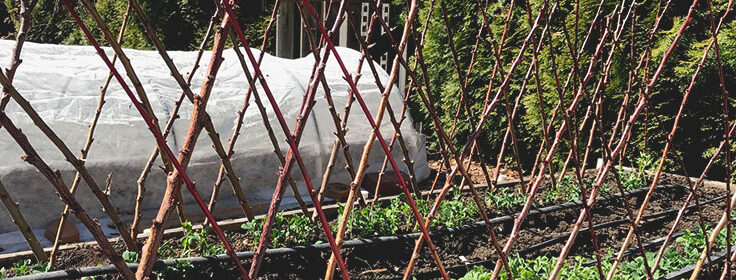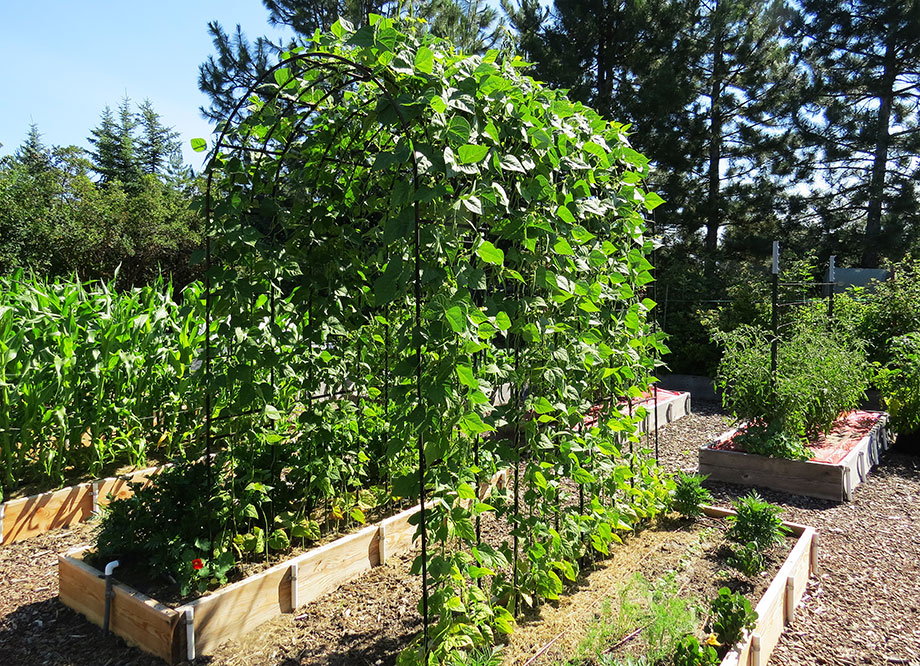Column: Vertical Gardening

For my garden column today, I talk about the benefits of using vertical gardening techniques within your veggie garden. They certainly add a cool factor to your garden. But vertical plant supports have a lot of side benefits, too. I hope you’ll enjoy it and expand your garden plans for this year!
Column:
by Susan Mulvihill
Growing a vegetable garden is considered by most to be a very practical thing to do. That doesn’t mean you can’t have a little fun. How? By adding some vertical gardening elements, both to maximize production and add a “wow” factor to your plot.
After a few years of growing bush beans, I switched to pole beans. That’s because one can squeeze more plants into a bed and the beans are easier to harvest. I used to make simple supports for them until I had a lightbulb moment.
What if I were to erect a series of metal garden trellises over the path between two raised beds? I envisioned the vines growing up and over the supports while I got to harvest the beans in the shade below. That was way back in 2008 and my new support system was such a success, I’ve never looked back. Best of all, the bean arbor is a focal point in the garden.
Other vining crops that are great candidates for growing vertically include peas, cucumbers, winter squash and pumpkins. I use pruned apple branches from our small orchard to support our pea vines. The branches are sturdy and don’t cost me a cent. Each year, I have fun arranging them in lattice patterns just to add a little interest to the pea patch.
I always used to grow our winter squash and pumpkins on the ground. The problem is that those vines sprawl all over the place, creating a tripping hazard and taking up valuable garden space.
After seeing some squash arbors on social media, I decided it was time to grow these crops vertically. We purchased two cattle panels – also known as livestock panels – from a farm supply store and created an arch over the path between two raised beds. The panels require heavy-duty, metal fence posts to stabilize the outside of the arch.
Once everything is in place, I plant my squash and pumpkin seedlings in the beds along the arch. Sometimes the plants need a little coaxing to grow vertically but soon they’re on their way, heading up and over the arch. There are many wonderful winter squash varieties that work great, such as Potimarron, Delicata, acorn, buttercup and butternut. New England pie pumpkins and cucumbers grow well on this support, too. If you grow larger varieties of squash or pumpkins, they will need a sling to support their weight as they mature.
I grow tomatoes up a support made from a sheet of concrete-reinforcing wire that is supported with metal fenceposts. While growing tomatoes up some type of support, or within a cage, isn’t anything new, there is a side benefit of keeping the foliage of all of the crops I’ve mentioned off the ground. When leaves make contact with the soil, there is a greater chance of disease issues since that’s where some pathogens exist. By supporting your plants, you are lowering the possibility of that problem in your garden.
If you don’t have a garden space but you do have a trellis or arbor in your yard that doesn’t have anything growing on it, create your vertical garden there. Loosen the soil on either side of the base of the trellis, remove any turf or weeds, and plant your seeds or seedlings.
No matter how you support your veggies, the vertical gardening elements in your garden are sure to transform it into an eye-catching space.
Susan Mulvihill is author of “The Vegetable Garden Problem Solver Handbook” and “The Vegetable Garden Pest Handbook.” She can be reached at Susan@SusansintheGarden.com. Watch this week’s video at youtube.com/susansinthegarden.

